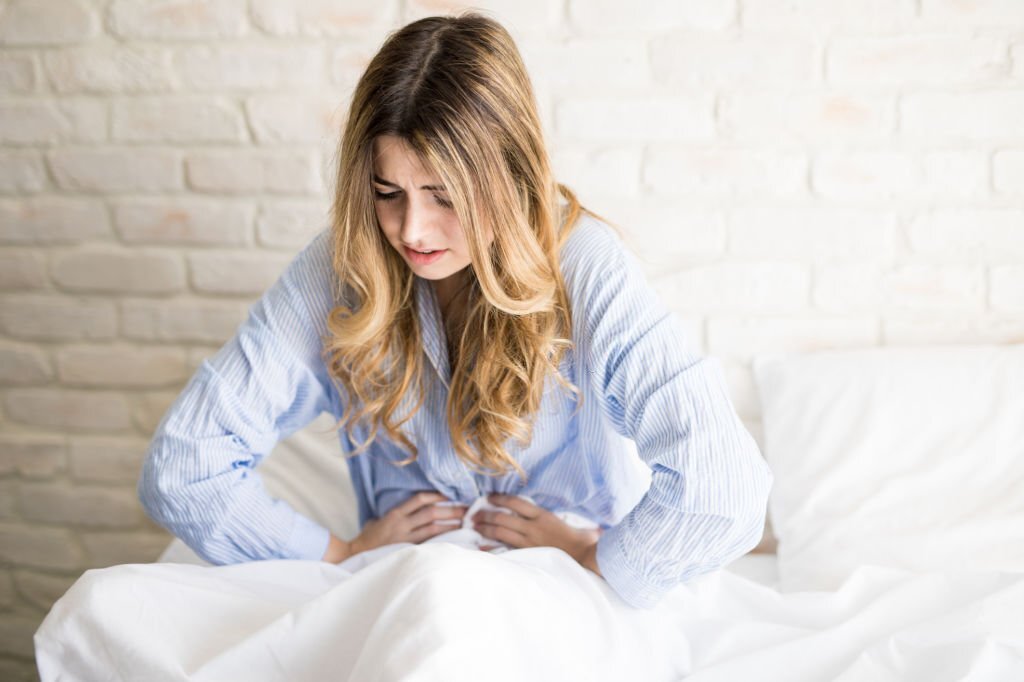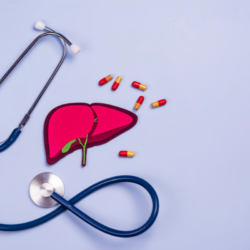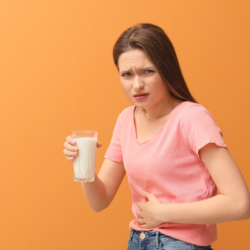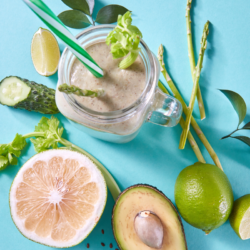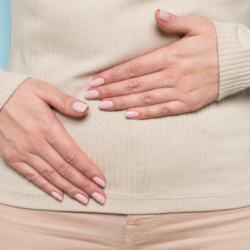There are different types of colic. Hepatic colic is characterised by acute pain in the right hypochondrium, radiating to the posterior, often associated with nausea and vomiting. It is associated with acute distension of the bile ducts. The main cause of hepatic colic is biliary lithiasis, responsible for around 98% of cases, but other possible causes should not be ignored: cancers (especially those of the ampulla of Vater), benign tumours, choledocholiths, certain parasites (flukes, roundworms and especially hydatid cysts ruptured in the bile ducts).
In this article, we will focus on lithiasis-induced hepatic colic. It is clear that, in hyperalgesic attacks of hepatic colic, classic antispasmodics provide rapid relief. Homeopathic treatment will then only play a supporting role, but it may be sufficient on its own in certain mild or moderate attacks.
What is hepatic colic?
The role of Belladonna in hepatic colic
The pain begins and ends abruptly. They are aggravated by the slightest touch, even grazing, and by shaking. The abdomen is tense and warm. General signs are often present: fever and cephalic congestion.
Dosage: If an urgent indication for surgery is ruled out, Belladonna 9 or 15 CH, 5 granules at the rate of the painful episodes.
It is often useful to alternate this medicine with one of the following, depending on the patient’s reactionary symptoms.
Colocynthis
The pain is spasmodic, violent, with a sudden onset and end. The patient is improved by being bent double by the heat and pressure: lying down in a stance like a rifle is particularly analgesic.
Dosage: Take 9 or 15 CH, 5 granules of Colocynthis every 10 to 15 minutes, spacing out as the symptoms improve.
Dioscorea villosa for the pain of gallstones
Dioscorea villosa is indicated at the same dosage as Colocynthis for patients whose paroxysmal pain improves in the opposite way to Colocynthis : by arching backwards. It is used much less frequently.
Bryonia alba
A medicine for inflammation of the serous membranes and parenchyma of the organs they enclose, Bryonia is taken in the following reactive forms:
- Stinging, throbbingpain in the hepatobiliary region, provoked or aggravated by the slightest movement, by strong inspiration. The patient is improved by lying on his right side and by wide pressure.
- Continuous or remittent fever with intense thirst for large quantities of cold water at long intervals, oily perspiration which relieves.
- Bitter taste in mouth, white tongue, dry lips.
- Hard, dry, black, voluminous stools, more frequently encountered than bilious diarrhoea at the slightest movement.
Dosage: Take 5 to 15 CH, depending on similarity, 5 granules every 2 hours. Space out according to improvement.
Berberis vulgaris and the spasmodic pains of hepatic colic
The pain is very acute, paroxysmal and stabbing. They radiate from a specific point to the stomach and abdomen. They are aggravated by movement and shaking, like Bryonia pain, but unlike Bryonia pain, they are aggravated by pressure. Painful sensitivity to pressure in the left costolumbar angle is often accompanied by highly variable urine quantity and concentration.
Dosage: Take Berberis vulgaris 5 to 9 CH, 5 granules 3 to 4 times a day.
Chamomilla
This medicine may be indicated for patients who are particularly intolerant of pain, agitated and short-tempered.
Recommended dosage: Take Chamomilla 15 or 30 CH, 5 granules 3 times a day.
Nux vomica in hepatic colic
This medicine is taken according to the digestive signs (spasmodic pain, nausea, vomiting, pyrosis) but above all according to a particular condition:
- Hypersensitive, sedentary patients.
- Usually prone to good food and overeating.
Dosage: Take Nux vomica 9 or 15 CH 2 to 4 times a day.
Ricinus communis
Hepatic colic manifests as pain in the girdle, accompanied by diarrhoea.
Dosage: Take Ricinus communis 5 CH, alternating with Belladonna, at the same time as the pain paroxysms.
Calcarea carbonica for inflammation of gallstones
While Calcarea carbonica is very effective in 15 or 30 CH in attacks of renal colic, it is much less effective in acute attacks of hepatic colic. On the other hand, it is an important background treatment for gallstones.
In a significant number of cases, therefore, homeopathic treatment, whether or not in combination with traditional antispasmodics, can be used to relieve patients suffering from hepatic colic. This method can also be used to treat lithiasis. Rare non-lithiasic causes of hepatic colic require aetiological treatment, which is usually surgical.
How can I avoid liver colic?
To prevent hepatic colic, it is essential to understand that prevention focuses primarily on reducing the risk of gallstone formation. Here are some key strategies:
-
Adopt a balanced diet:
- We recommend eating fibre-rich foods such as fruit, vegetables and wholegrain cereals.
- Reduce consumption of foods high in saturated fat and cholesterol, such as red meat, high-fat dairy products and fried foods.
- Include healthy fats such as those found in olive oil, nuts and oily fish.
-
Maintain a healthy body weight:
- Obesity is a major risk factor for the formation of gallstones.
- Lose weight gradually and avoid crash diets, as rapid weight loss can increase the risk of stone formation.
-
Regular physical exercise:
- Regular physical activity helps maintain a healthy weight and may reduce the risk of gallstones.
- Moderate activity, such as brisk walking, is recommended for at least 30 minutes most days of the week.
-
Adequate hydration:
- Drinking enough water throughout the day helps prevent the formation of gallstones by aiding digestion and keeping bile fluid.
-
Avoid certain medicines if possible:
- Certain medicines, such as oral contraceptive pills and hormone therapies, can increase the risk of gallstones forming.
- Discuss possible alternatives or associated risks with a doctor.
-
Regular medical check-ups:
- Regular check-ups can help identify problems early on.
- People with a family history of gallstones should be particularly vigilant.
What foods cause gallstones?
The formation of gallstones can be influenced by various factors, among which diet plays a significant role. Although it is not possible to attribute the formation of gallstones to a specific food, certain types of food are known to increase the risk.
Foods rich in cholesterol
Foods high in cholesterol are often singled out as major contributors to gallstone formation. The liver uses cholesterol to produce bile, and excess cholesterol in the diet can lead to an overproduction of bile, which increases the risk of stone formation. Foods such as fatty meats, high-fat dairy products and eggs are common sources of high cholesterol.
Fatty and fried foods
Foods high in fat, particularly saturated and trans fats, are also associated with an increased risk of gallstones. Fried foods, cold meats and certain types of cheese and meat are examples of products high in saturated fats. Not only can these fats raise cholesterol levels in the body, but they can also slow down the process of emptying the gallbladder, making it easier for stones to form.
Refined foods and sugar
Foods with a high glycaemic index, such as refined sugar, white bread and other bakery products, can influence the formation of gallstones. High sugar consumption leads to increased insulin levels in the blood, which can affect biliary function and contribute to the formation of stones.
Alcohol
Excessive alcohol consumption is another factor that can contribute to the formation of gallstones. Alcohol can affect the liver’s ability to metabolise fats and cholesterol, increasing the risk of developing gallstones.
In summary, although many factors can contribute to the formation of gallstones, diet plays a crucial role. A balanced diet rich in fibre and low in saturated fats, cholesterol, refined sugar and alcohol is recommended to minimise the risk of developing gallstones. It is also important to stress that eating habits should be part of an overall healthy lifestyle, including regular physical activity and weight management.

